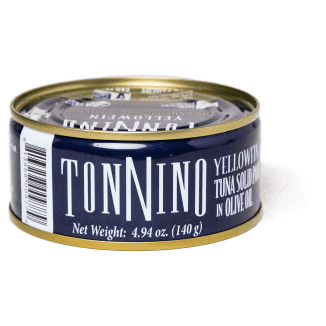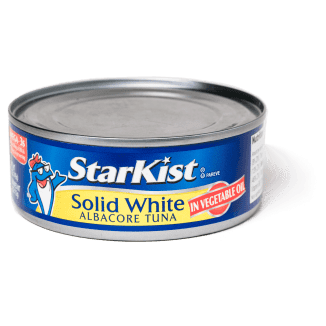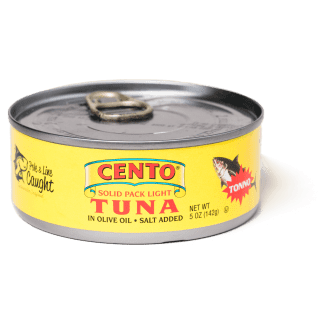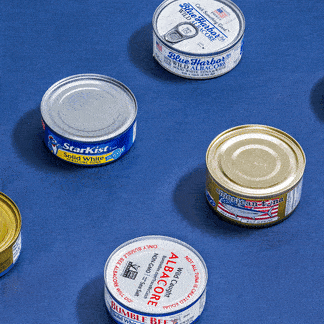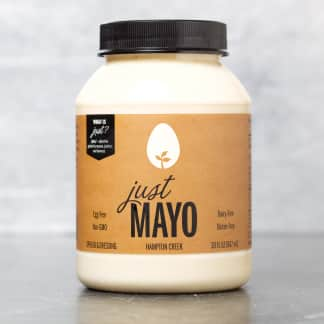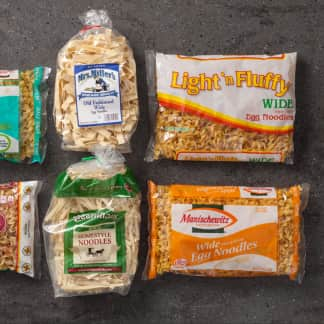Canned fish is having a moment. More and more trendy restaurants across the country have begun featuring preserved, tinned seafood on their appetizer boards. In the test kitchen, we always keep canned or jarred oil-packed tuna in the pantry for use in recipes such as salade niçoise and pan bagnat, pasta dishes, and crostini—and to compose our own restaurant-style appetizers. Unlike water-packed tuna, which is primarily used as an ingredient in tuna salad and casseroles, oil-packed tuna is ready to serve straight from the container, with little to no intervention on the part of the cook. At its best, this fish has a moist, silky texture and rich, meaty taste that is enhanced by being preserved with oil. But given that it’s not going to be disguised in a casserole, which product should you buy to enjoy the best flavor and texture?
Why We Tasted 16 Oil Packed Tunas
Americans eat about 1 billion pounds of canned, jarred, and pouched tuna a year. According to the National Fisheries Institute, only coffee and sugar exceed canned tuna in dollar sales per foot of shelf space in the grocery store. In our desire to decode the teeming tuna aisle, we figured that there were just too many variables—the species of tuna, the packaging (can or jar), and the packing medium (oil or water), among others—to eliminate styles without tasting them all. So we narrowed our search to 16 products packed in oil, including both canned and jarred tunas and both albacore and yellowfin species, which are often labeled “white” and “light” tuna, respectively. Some were sold as “solid,” others as “chunks,” and yet others as “fillets.” The oil they were packed in ranged from soybean oil to regular olive oil, and even extra-virgin olive oil. Some products specified that they were seasoned with sea salt, and a few included additives such as vegetable broth and pyrophosphates. (We eliminated pouched styles from this lineup after a pretasting showed that the soft pouch tends to smash and break up the big flakes and chunks we prefer for maximum versatility.)
Americans eat about 1 billion pounds of canned, jarred, and pouched tuna a year.
We removed them from their containers as carefully as we could to preserve their texture and served them plain in two blind tastings. Tasters were very enthusiastic about the best tunas, describing them as dense, meaty, and silky, with “rosy” flakes and chunks that were “beautiful to look at,” and packed with rich, “clean” seafood flavor. And then there was the other end of the spectrum: Tasters called the worst samples “mushy,” “stringy,” “flabby,” “soggy and wet,” “spongy and greasy,” “tinny,” or “metallic,” with plenty of complaints that they were overly “fishy.” Several even brought up “cat food.” As for the packing medium, in high-rated samples tasters said the oil complemented and enhanced the tuna’s flavor, but in low-rated samples, as one taster put it, “I could taste the oil, but not in a good way.”
Key Factor In Tuna: How Moist Is It?
Aside from the few truly detested samples, one factor stood out as making the biggest difference to our tasters: dryness. Tasters described higher-rated products as moist, finding them “tender,” “silky,” and “juicy.” Even when tasters enjoyed the flavor of a sample, it lost points if it was dry. Tasters found these tunas “cottony” or “sawdust-y,” mealy, and tough. “This turns to dust as I chew,” one taster complained. “Breaks into splinters rather than flakes,” another wrote. So if moistness is a key factor, why were some products drier than others? It helps to understand a little about how tuna goes from ocean to can.
Here’s a quick overview: Freshly caught fish are frozen on the ship. At the plant, they’re inspected and thawed and then steam-cooked and cut up to remove the meat. The meat is then put in cans or jars with oil, salt, and any other ingredients; sealed; and finally pressure-cooked again inside the can to seal the jar and sterilize the contents.
According to tuna processing experts, things can go wrong at several stages. First, the fish has to be frozen fast and kept that way, or quality suffers. If not, ice crystals form in the meat and puncture cell walls, letting moisture leak out when the tuna thaws, just as you see with “freezer-burned” food at home. Proper freezing also halts the enzymes that will naturally start to break down the fish, helping to preserve flavor and texture. Second, the tuna goes through what one food scientist called the “critical thermal processing steps” at the plant that can make or break its flavor and texture. As we described, the fish is heated and cooled a few times, so timing and temperatures matter. Worst case? It gets overprocessed and/or overcooked. Similar to what happens when a beef steak is cooked to well-done, the tuna’s proteins lose their ability to hold moisture, and the texture becomes tough, dense, and dry. While packing tuna in oil offsets some of the sensation of dryness, it can only do so much, as our tasters noted. We aren’t privy to the precise processing conditions of each product, but it’s probable that products rated highly by the tasting panel are taking more care to retain the moist texture we preferred. As for one tuna that is sold in a glass jar, this is a likely indicator of moist, tender tuna, since glass can't withstand the high-heat treatment that be used for cans, so the contents are given a lower-temperature pasteurization which results in fish that is more moist.

As for other factors, the species of tuna didn’t matter on the high end: Of our top two products, one was albacore, the other yellowfin. On the low end of the rankings, the species of tuna probably did play into their problems: The bottom few products didn’t specify species other than calling their tuna “light,” which can include stronger-tasting bluefin or skipjack, or darker portions of yellowfin. As for the style, we generally liked solid rather than chunk style, though one of our co-winners was cut into rectangular fillets—the only one in the lineup in that shape. Similar to solid-style tunas, these fillets were easy to remove from their jar in appealingly large pieces. The oils had some small effect on ratings: We usually preferred the flavor of tunas packed in olive oil over those packed in more neutral vegetable oil, but while three of the six tunas packed in extra-virgin olive oil landed in the top half of the rankings, our top picks were packed in just regular olive oil. Three of the four samples that contained added vegetable broth, a trick to enhance flavor, fell into the lower half of the rankings. Fat and sodium levels on the labels didn’t align directly with our preferences; because total fats reported on the label include the added oil as well as any fat in the fish, our perceptions of the moisture of the meat itself weren’t represented by those numbers. And while our tasters noted that some samples tasted a bit “salty,” they didn’t deduct points for this. In general, tasters approved of “well-seasoned” tunas a bit more than those deemed “bland.”
Why Do The Cans Say “Pole And Line Caught”?

One other factor that may have contributed to the condition of the fish was the way they were caught. One of our top two products identified its tuna as being "pole and line caught" (see Tuna Terms You Need to Know), and the other indicated that some of its fish is caught with this method, and stated that it only purchases tuna from boats with onboard observers and divers to prevent unwanted species from being caught. Several others lower down in our rankings did not specify how the tuna was caught. Watchdog organizations such as the Monterey Bay Aquarium’s Seafood Watch and the Marine Stewardship Council (MSC) consider pole and line fishing techniques to be one of the more environmentally friendly ways to catch tuna, along with troll fishing (dragging baited fishing lines behind a slow-moving boat), as opposed to fish aggregating devices (FAD), trawl, and purse seine fishing, which employ large nets that often capture and kill other species of sea life along with the tuna they’re seeking. Some seafood experts believe that the netted fish can be damaged and stressed more than pole- or line-caught tuna, which may affect its flavor and texture.

The Best Oil Packed Tunas: Tonnino And Ortiz
Two tunas stood above the rest, tying for first place and earning the highest recommendation from our tasting panel: Tonnino Tuna Fillets in Olive Oil, which are sold in a clear glass jar, and Ortiz Bonito del Norte Albacore White Tuna in Olive Oil, which comes in a distinctive oval tin. Both are a bit pricier than the average can of supermarket tuna, but we think it’s worth it for higher-quality tuna. While the Tonnino fillets are yellowfin tuna and the Ortiz are albacore, they shared the moist, silky texture and “clean,” bright, well-seasoned flavor we were looking for. Both contained big, smooth, intact, and pleasantly firm flakes of tuna that looked appealing and tasted just right, whether we were topping a composed salad, making an appetizer board, or tucking them into a pan bagnat. We’re happy to stock them in our pantry.
- Moist, silky texture
- Clean, bright flavor
- Firm and meaty with big flakes
- Well seasoned, so it’s ready to eat right out of the container
- Olive oil that complements the flavor of the tuna
- Sixteen top-selling oil-packed tunas of various species and styles, including chunk and solid styles
- Prices ranged from about $0.25 to about $1.39 per ounce
- Packing mediums included vegetable oil, soybean oil, olive oil, and extra-virgin olive oil
- Blind, randomized tastings of the plain tunas, with two groups of 21 staffers




